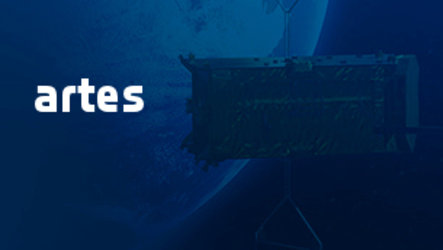Perfect propulsion pointing: a main achievement of the Neosat programme
The first flight models of the Electric Propulsion Pointing Mechanisms (EPPM) have been delivered by RUAG Space Austria to Thales UK’s Belfast assembly centre.
Designed and manufactured by RUAG Space Austria, they are a key element of the new Spacebus Neo telecom satellite developed by Thales Alenia Space under ESA and CNES Neosat telecommunication programme.
These units will fly on the first Spacebus Neo satellite, Eutelsat’s KONNECT.
Precision pointing
The ‘all electric’ Spacebus Neo satellite can efficiently use the low force generated by the thrusters to change or maintain orbital position in addition to management of angular momentum.
This flexibility is achieved through precise positioning of the plasmic thrust thanks to the pointing mechanism. At launch, the pointing mechanism secures the thruster in a compact stowed position. Following satellite separation from the launch vehicle, locks are released to allow the thruster assembly to be deployed.
The EPPM is able to accommodate and point 5 kW plasma thrusters with its associated electrical harness and propellant feed lines. It was carefully designed to minimise mass, isolate the thruster mechanical launch loads, manage orbital temperature extremes and deliver exact pointing accuracy over a 15 years’ service lifetime.
Becoming an assembly
Teams in Thales Belfast will now prepare each pointing mechanism to receive an electric thruster and its associated hardware. The completed assemblies will be shipped to Thales Alenia Space Cannes in France for integration to the satellite.
Thereafter, extensive tests will be performed at satellite level including deployment and pointing checks of the propulsion mechanisms.
The satellite will be launched from French Guiana next year on an Ariane 5, and will travel to its final orbital slot on the geostationary arc over the course of six months, thanks to RUAG pointing mechanisms.
A partnership framework achievement: fast track to flight validation and introduction to market

The EPPM development is an excellent demonstration of how the ARTES Partnership Programme framework can bring benefit to all stakeholders through timely fostering of European capabilities in answer to market needs and opportunities.
RUAG Space Austria have developed the EPPM under ESA/CNES and the satellite prime leadership, thus providing the most direct route to guide the development, accomplish performance requirements and competitiveness targets. The ARTES Partnership Programme arrangement offers fast track opportunity to validate products in orbit securing its acceptance by the commercial worldwide market, leading to earlier and more effective return of investment for industry and its supporting Member State.
Under an established ARTES Partnership Programme framework, the ESA co-management approach with the satellite prime contractor is tailored to the size and maturity of the projects and to the corresponding commercial best practices, maximising financial return for industry.
Max Kowatsch, Managing Director of Ruag Austria, said: “Pointing Mechanisms for the continuously increasing need for Electric Propulsion systems on many different types of satellites have been the focus of RUAG Space mechanism developments for many years. The Neosat Partnership Programme has enabled quick and efficient support and has allowed RUAG Space to seize this opportunity, where schedule and time-to-market were extremely challenging. Many thanks to the Austrian Delegation and ESA.”
In the case of EPPM, Ruag Space Austria and Thales Alenia Space were quickly able to engage in a fast track co-engineering phase, consolidating the technical and schedule requirements to meet the application demands.
The Neosat framework in place between ESA, CNES, the member state, the prime and eventually the operator has enabled Ruag Austria to deliver the first flight hardware in just two years.
Andreas Mauroschat, Neosat Programme Manager at ESA said: “It is an extraordinary technical achievement to have designed and delivered such a complex and critical element for Spacebus Neo in such a short period. Here we have an excellent example of how the ARTES framework can support timely development and flight demonstration of technologies in answer to market need, supporting the competitiveness of our Member States’ industry.”
National Agencies and Delegations subscribing to an ARTES Partnership Programme benefit from close understanding of the commercial market needs enabling them to define their strategic plans for their own national space sector.

Product enrichment through direct interaction with satellite integrators is another unique feature of the ARTES Partnership Programme approach that leads to quicker and more effective return on investment for the supporting delegation and the supplier.
Luc Berset from the Austrian Research Promotion Agency (FFG) and National Delegate at the ESA Joint Board on Communication Satellite Programmes said: “We are extremely happy about the Austrian participation in the Neosat Programme. The Neosat cooperation between the prime contractor and our Austrian supplier industry has created significant business opportunities with recurrent sales and sustainable jobs in Austria. Working with an ESA Partnership Programme is a great way to maximise the Return on Investment (ROI) for our Austrian industry.
“We are looking forward to continuing our involvement in ESA flagship programmes, needed to catalyse substantial investments resulting in a competitive leap for our industry.”
The Neosat programme
The new Spacebus Neo product line is developed in the frame of ESA's Advanced Research in Telecommunications Systems (ARTES) programme, in cooperation with space agencies from ESA Member States, and managed jointly by ESA and CNES.
The Neosat programme comprises both Spacebus Neo by Thales Alenia Space and Eurostar Neo by Airbus Defence and Space. It includes development up to in-orbit validation of the new satellite product lines for both companies, allowing European industry to deliver competitive satellites for the commercial satellite market.





